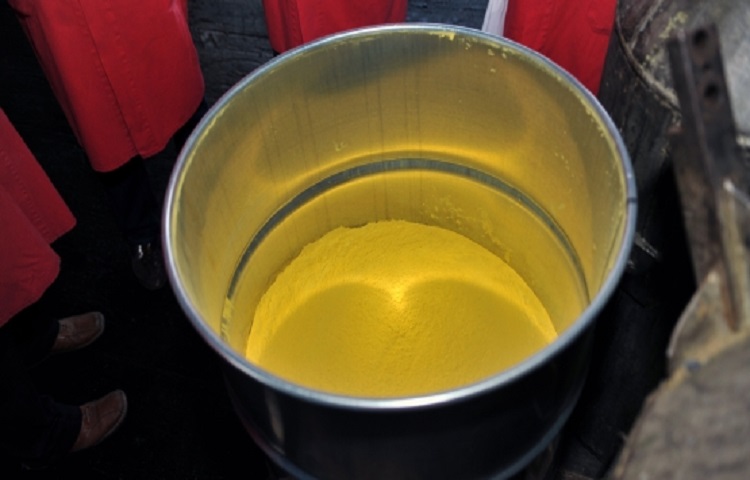Safe and secure passage for uranium shipments is vital for Nuclear Industry
The IAEA works with authorities worldwide to train personnel and help develop national safety and security regulations for transporting uranium.

Uranium shipments are like VIP travelers. They go by land, sea or air and have layovers like any other traveler, but their global influence and appeal to criminals means every detail of their journey is designed to ensure safety and security each step of the way.
“Uranium is only produced by a few countries and is required to produce fuel for most nuclear power plants worldwide, which is why it’s a high-value, strategic global commodity,” said Robert Floyd, Director General of the Australian Safeguards and Non-Proliferation Office (ASNO). “Given the need to transport uranium globally, it is important that high standards are sustained internationally.”
More than 80% of the uranium used worldwide is produced by just five countries. Of the 31 countries that operate 450 nuclear power reactors, few produce their own uranium. This means that more than 50,000 tonnes of uranium ore concentrate is typically shipped each year.
Uranium is a naturally occurring radioactive element. Uranium ore concentrate, or yellowcake, is a concentrated powder form of uranium made by removing impurities from raw uranium ore. (For more information on how yellowcake is made, see page 23 of the IAEA Bulletin on Uranium: From Exploration to Remediation). Most uranium is shipped as yellowcake because it is more cost-effective than transporting unrefined uranium ore.
Although yellowcake poses little radiation hazard, it still requires safe handling. “From a safety perspective, only basic radiation protection measures are necessary,” said Eric Reber, a transport safety specialist at the IAEA.
From a security standpoint, explained David Ladsous, an IAEA senior nuclear security officer, “protection measures ensure uranium does not end up in the wrong hands. They are particularly important because uranium has major economic and strategic value that can also motivate theft or sabotage.”
The IAEA works with authorities worldwide to train personnel and help develop national safety and security regulations for transporting uranium. National regulations for the safety and security of radioactive material should be designed to meet international standards and be integrated into a global safety and security regime, Reber said. This joint effort covers the whole transport process, from production and packaging to transit routes and delivery. It also addresses potential issues such as piracy.
“Even though the transport of yellowcake is of relatively lower risk than other parts of the nuclear fuel cycle, having high standards of safety and security is vital to building domestic and international confidence in the nuclear industry as a whole,” Floyd said.
Confidence is built in part on these national regulations and international standards because it means all countries in the supply chain are working within the same high standards of safety and security, Ladsous said. This is particularly important for new or small uranium producers and countries such as Malawi that is trying to re-enter the uranium industry.
“Up until recently, one of our biggest challenges was the possibility that our interim competent authority, the Environmental Affairs Department, may not be recognized by other countries as having an acceptable mandate in the transport of radioactive material, including yellowcake, and so some shipments could be occasionally denied,” said Burnett Msika, Chief Mining Engineer in the Department of Mines in Malawi’s Ministry of Natural Resources, Energy and Mining.
Although in 2014, Malawi temporarily closed its only mine after five years of operation owing to a crash in uranium prices and high operating costs, the country is actively updating its regulations and training staff with the support of the IAEA to prepare uranium operations to restart.
“That’s part of why, through the Environmental Affairs Department, we have made our national atomic energy regulatory authority operational and are building and strengthening human resources and improving collaboration with regulators throughout the transport process,” Msika said.
For more experienced exporters like Australia the third largest producer of uranium and home to the world’s largest uranium deposits, the focus is on maintaining confidence as reliable energy exporters.
Australia constantly reviews and updates its regulations and permits and trains staff to ensure its 8,000 tonnes of exports each year reach their final destinations, Floyd said. Each Australian state and territory has additional regulations and codes for transport. Together, these set out the requirements for packaging, conveyances, routes and safety and security for transporting yellowcake.
Coordinating this work across state and federal levels is particularly important for such a large country. “Australia is the sixth largest country in the world, so one of the major challenges we have to deal with is covering long distances, often going through vast remote areas. If an incident happens, help can take a long time to arrive. It’s important to be prepared and has continuous communication, self-reliance, and the right tools,” Floyd said.
Australian authorities plan to continue working closely with the IAEA to further strengthen the country’s transport regime. Action items for the future include producing a consolidated list of national resources available in the event of an incident, improving training materials and developing a model guide for yellowcake transport plans to enhance understanding of new mining endeavors.
- READ MORE ON:
- IAEA
- uranium
- nuclear industry
- VIP travelers
- Safeguards
- Environmental Affairs
ALSO READ
IAEA Board to meet on Zaporizhzhia attacks on Thursday, diplomats say
Russia says it calls emergency IAEA board meeting on Zaporizhzhia attacks
IAEA head says drone attack on Zaporizhzhia nuclear plant significantly increases risk of major accident, reports AP.
Drone attack on Zaporizhzhia nuclear plant significantly increases accident risk, IAEA head says
IAEA Board to meet on Ukraine's Zaporizhzhia on Thursday, diplomats say










